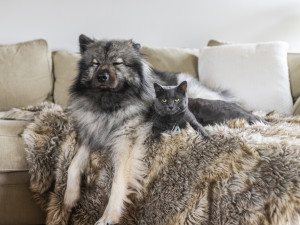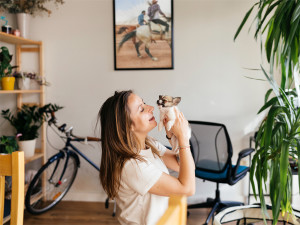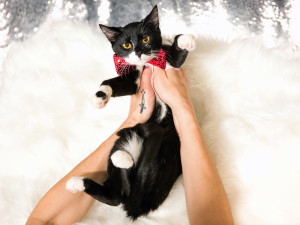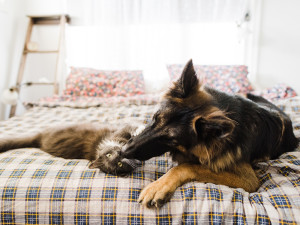Will Cats & Dogs Ever Get Along? Experts Debunk the Rivalry Myths
Think cats and dogs are natural enemies? Think again
‘Fighting like cats and dogs’. Cat people vs dog people. It seems we’ve always painted them as rivals, never companions. Right? Films, TV shows, cartoons and even popular sayings have often portrayed cats and dogs as mortal enemies, but how much of the rivalry is grounded in reality?
The question hit home for me recently when my partner and I decided to introduce our pets – his cat and my dog. As expected, it was... an experience. The cat shot up to the highest shelf, and my dog, assuming Teddy (the cat) was a giant toy, was ready to play! It left me wondering: will these two ever get along? Are all those myths about cats and dogs actually true?
To answer the age-old conundrum, we consulted the experts to debunk eight common myths on the relationship between cats and dogs, and find out whether the two really can live side-by-side in peace.
Dogs and cats are natural enemies
Films and cartoons have pitted dogs and cats against each other as natural enemies, but this simply isn’t true. Many cats and dogs can live peacefully together and even become friends with proper introductions and patience.
Dogs Trust’s Generation Pup researchopens in new tab supports this, revealing that the way cats and dogs are introduced, as well as a puppy’s age, can significantly impact their behaviour toward each other. So, it’s not about whether they’re natural rivals; it’s more about how you introduce and train them. Nature vs nurture, I guess.
If they don’t get along right away, they never will
It’s unlikely that bringing a new pet into the household will go swimmingly with the other four-legged sibling straight away.
Gradual introductions significantly increase the likelihood of a positive relationship. However, over 20 percent of pet parents introduce their puppy to existing household cats immediately, without a gradual introduction, and almost 19 percent do it in less than two hours.
According to the Dogs Trust studyopens in new tab, puppies introduced to cats over more than one day, particularly those younger than 12 weeks, are more likely to display desirable behaviours such as calmness and playfulness, leading to a friendlier dynamic.
“Think in terms of weeks rather than days when introducing cats and dogs,” says dog and cat behaviour consultant, Katherine Brownopens in new tab, “and think in terms of months rather than weeks for them to completely adjust to each other and start developing a relationship.”
“Don’t rush it,” she adds. “It’s better to proceed too slowly than too quickly. They have their whole lives to form a bond, they don’t have to do it on day one.”
Cats and dogs can’t share the same space
Can cats and dogs live happily in the same household? Can they share space without tearing each other’s fur out? Absolutely!
If you’re worried that bringing a new puppy into your home will disrupt your cat’s peaceful life, don’t worry. With a little planning and some basic precautions, many cats and dogs can share spaces without constant conflict.
“Make sure each animal has their own facilities, and can eat, drink, sleep and toilet peacefully,” says Katherine.
“For cats, they must have hiding places and access to raised surfaces where they can get away from a dog easily,” she adds. “This gives them a sense of security and prevents competition. Some management and training might be necessary to keep things harmonious, but it’s worth it for a peaceful home.”
Dogs always chase cats to hunt them
Many dogs are triggered to chase when they see something small moving fast, which is why cats often end up being victims. There are many reasons a dog might chase your cat:
Instinct: there may be a hunting instinct in some dogs, or a genetic inclination to chase such as in the herding breeds.
Play: they’ve learned it’s fun.
Boredom: they’re under-stimulated and bored.
Territoriality: the home has insufficient resources and the cat is a perceived threat to the dog’s wellbeing.
Fear: some dogs may simply not like cats and want them as far away as possible (which chasing often achieves).
“Chasing behaviour can be very stressful and potentially dangerous for your cat, so monitoring and preventing it is essential,” says Katherine. “Make sure your dog has plenty of interactive playtime with toys so they don’t feel the need to chase your cat for fun.”
A dog’s excitable behaviour or rough play can make a cat feel threatened which may lead to swiping or hissing, adds Katherine. “Both animals can show aggression when they feel uncomfortable, so it's important to recognise their individual needs and boundaries,” she says. “Cats and dogs should never be forced to be close to each other, as this can easily lead to a defensive reaction and conflict.”
Small dogs get along better with cats
Small dogs may look less intimidating due to their size, but that doesn’t guarantee they’ll get along with cats any better than larger dogs. “Some cats may be nervous around any dog, regardless of size,” says Katherine.
“A dog’s size is less important than their temperament, energy level, training, and past experiences with cats,” she adds. “The key is proper introduction, training, fulfilling each animal’s unique needs, and ensuring each animal feels safe.”
Cats and dogs can’t communicate
It's more likely that your pets will learn to tolerate and respect each other’s personal space through body language rather than exchanging barks and meows, but over time, they may develop their own unique way of communicating.
“While cats and dogs have different communication styles, they can learn to understand each other’s signals over time,” says Katherine. “Our role is to provide them with a calm and reassuring space in which they can learn to communicate with each other safely.
“It helps if the human caregiver has spent some time learning a bit about both dog and cat body language to spot when they may need some help or intervention. Cats and dogs primarily communicate through body language, as scent-based communication such as pheromones tends to be species-specific.”
Cats will always be stressed around dogs
“Not all cats are stressed around dogs, but much depends on their individual personalities and experiences,” says Katherine. “If your cat has had negative experiences with dogs in the past, they’re likely to feel more fearful.
“On the other hand, some cats are extremely confident and may even take charge in a household of dogs – it’s all about careful introductions and making sure both animals feel safe.”
Cats and dogs can’t be left alone together
Once you’ve spent time making sure your cat and dog are comfortable with one another, it’s possible to leave them alone together – but only when you’re certain they’re both safe. If either pet still seems unsure, or if they haven’t been properly introduced, never leave them unsupervised.
“Taking the time to train, supervise and observe their interactions will help build a trusting relationship over time. Until you're 100 percent confident they can coexist peacefully, keep them separated when you're not around,” adds Katherine.








